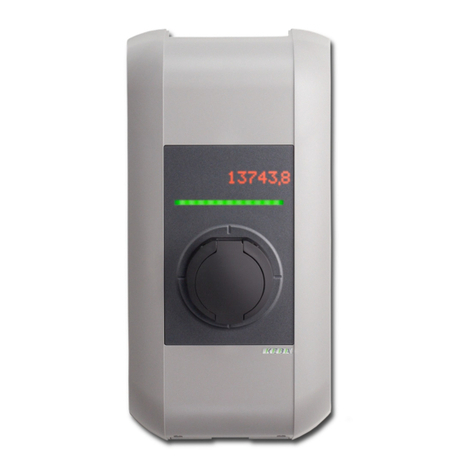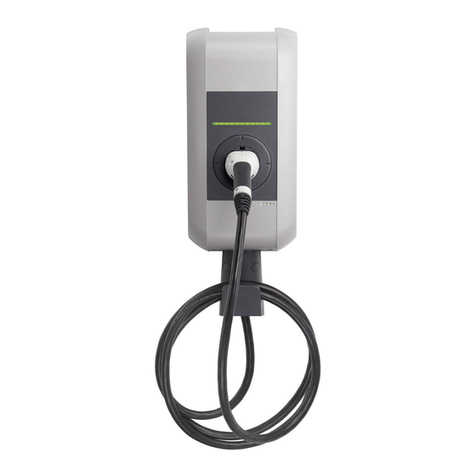
Autorisierungsfunktionen
8/112 - de
1.3 RFID Autorisierung
Master/Slave Betrieb (Ladenetzwerk)
Ist die Ladestation Teil eines Ladenetzwerks (P30 c-series als Slave in einer Master/Slave-Installation), so
müssen alle RFID Karten auf der Master-Ladestation (P30 x-series) eingelernt werden. Die Aktivierung oder
Deaktivierung der Autorisierungsfunktion und die Whitelist für das gesamte Ladenetzwerk werden am Master
verwaltet. Entnehmen Sie die Informationen zu dieser Installationsvariante bitte dem spezifisch beiliegenden
„Konfigurationshandbuch“.
Visualisierung LED Balken
● Ist keine Autorisierung für eine Ladesitzung erforderlich, blinken alle 4 Segmente der LED Balkenan-
zeige der Ladestation im Idle Zustand (=Leerlauf) grün.
● Ist eine Autorisierung für eine Ladesitzung erforderlich, blinken alle 4 Segmente der LED Balkenanzei-
ge der Ladestation im Idle Zustand (=Leerlauf) blau. (Autorisierung entweder mittels Schlüsselschalter,
RFID Karte oder externem Eingang notwendig).
● Permanentes, oranges Leuchten des LED Segments [S4] bedeutet, dass das Einlernen einer Slave
Karte durch erneutes Vorhalten der Master Karte bestätigt werden muss.
Akustische Signale
Ansteigende Tonfolge:
RFID Karte wurde gelesen und akzeptiert.
Absteigende Tonfolge:
RFID Karte wurde gelesen und abgelehnt (keine Berechtigung).
Autorisierung aktivieren/deaktivieren, Whitelist löschen und Master Karte einlernen
Um die Autorisierung zu aktivieren, zu deaktivieren, die Whitelist zu löschen oder eine Master Karte einzuler-
nen, darf keine Ladesitzung aktiv sein und es darf auch kein Fahrzeug an der Ladestation angesteckt sein.
Für den Zugriff auf den Service Taster müssen das Designcover und die Anschlussfeldabdeckung entfernt
werden.
Drücken Sie den [Service] Taster im Anschlussfeld so lange, bis der zweite Signalton ertönt.
Die Ladestation führt nun automatisch einen Neustart durch und löscht dabei die interne RFID Whitelist.
Direkt nach diesem Neustart der Ladestation kann für 60 Sekunden, durch das Vorhalten einer RFID
Karte, die Master Karte angelernt werden. Eine gültige Karte wird mit einem Signalton bestätigt und da-
mit wird die Autorisierungsfunktion aktiviert.
Verstreicht dieses Zeitintervall ohne das Einlernen einer Master Karte, dann wird die RFID Autorisie-
rungsfunktion der Ladestation deaktiviert.
Hinweis
Nach dem Anlernen der Master Karte blinkt die Ladestation noch für 60 Sekunden grün und es
kann eine, durch den Master autorisierte, Ladesitzung gestartet werden. Danach wechselt die La-
destation in den nicht autorisierten Idle Zustand und blinkt blau.
































